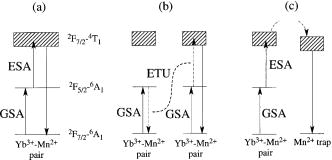Research
Highlights 2002
 S. Heer, M. Wermuth, K. Krämer and H. U. Güdel
S. Heer, M. Wermuth, K. Krämer and H. U. Güdel
Sharp 2E upconversion luminescence of Cr3+ in Y3Ga5O12 codoped with
Cr3+ and Yb3+
Phys. Rev. B 65, 125112/1-10 (2002)
![]()
![]()
Abstract:
We report on upconversion luminescence in Y3Ga5O12
codoped with Cr3+ and Yb3+. This is, to our knowledge, the first upconversion
process directly involving Cr3+. At low temperature
excitation around 10 314 cm–1 leads to relatively strong
red luminescence in the title compound. The sharp upconversion
luminescence around 14 300 cm–1 is identified as the
2E ![]() 4A2 transition of
Cr3+. The upconversion excitation spectrum follows he
Yb3+ 2F7/2
4A2 transition of
Cr3+. The upconversion excitation spectrum follows he
Yb3+ 2F7/2 ![]() 2F5/2 absorptions
in the range 11200 - 10315 cm–1. From transient measurements the upconversion
mechanism is found to be dominated by an energy transfer step: Two
excited Yb3+ ions simultaneously transfer their excitation
energy to the Cr3+ ion. In
Y3Ga5O12:2% Cr3+, 1%
Yb3+ the efficiency of the process at 10 K and for 150 mW
laser power is 6% and decreases with increasing temperature due to
intrinsic loss mechanisms of the system.
2F5/2 absorptions
in the range 11200 - 10315 cm–1. From transient measurements the upconversion
mechanism is found to be dominated by an energy transfer step: Two
excited Yb3+ ions simultaneously transfer their excitation
energy to the Cr3+ ion. In
Y3Ga5O12:2% Cr3+, 1%
Yb3+ the efficiency of the process at 10 K and for 150 mW
laser power is 6% and decreases with increasing temperature due to
intrinsic loss mechanisms of the system.
 Oliver S. Wenger and Hans U. Güdel
Oliver S. Wenger and Hans U. Güdel
Luminescence spectroscopy of V3+-doped Cs2NaYCl6 under high pressure
Chem. Phys. Lett. 354, 75-81 (2002)
![]()
![]()
Abstract:
The luminescence behavior of 1% V3+:Cs2NaYCl6
at room temperature is studied as a function of hydrostatic pressure. At
ambient pressure the V3+ 3T2g excited
state origin lies 234 cm–1 above the 1T2g
first excited state. At room temperature the two states are in thermal
equilibrium, and spin-allowed 3T2g ![]() 3T1g
emission is dominant. Pressure increases the energetic separation of 1T2g
and 3T2g, leading to a decreasing 3T2g
steady state population at constant temperature. This manifests itself in
an increasing relative amount of spin-forbidden 1T2g
3T1g
emission is dominant. Pressure increases the energetic separation of 1T2g
and 3T2g, leading to a decreasing 3T2g
steady state population at constant temperature. This manifests itself in
an increasing relative amount of spin-forbidden 1T2g ![]() 3T2g
luminescence, as evidenced by the occurrence of sharp luminescence
features and an increase in the luminescence decay time at higher
pressures.
3T2g
luminescence, as evidenced by the occurrence of sharp luminescence
features and an increase in the luminescence decay time at higher
pressures.
 Rafael Valiente, Oliver S. Wenger and Hans U. Güdel
Rafael Valiente, Oliver S. Wenger and Hans U. Güdel
Upconversion luminescence in Yb3+ doped CsMnCl3: Spectroscopy, dynamics, and mechanisms
J. Chem. Phys. 116, 5196-5204 (2002)
![]()
![]()
Abstract:
Single crystals of CsMnCl3 doped with 0.9% Yb3+
were grown from the melt by the Bridgman technique and studied
by means of variable temperature optical spectroscopy. At
cryogenic temperatures, near-infrared Yb3+-excitation around
1 mm leads to intense Mn2+ upconversion luminescence in the
red spectral region. This very efficient upconversion process is possible
because of magnetic Yb3+-Mn2+ exchange
interactions, and a new type of upconversion mechanism is found
to be active in this system. The upconversion properties of Yb3+:CsMnCl3
are compared to those of Yb3+:RbMnCl3 and
Yb3+:CsMnBr3. The upconversion efficiencies at
cryogenic temperatures differ by many orders of magnitude. The
bridging geometry between Yb3+ and Mn2+
is found to be a key factor for the efficiency of the process.
The highest efficiency is observed for the title compound, and
this is correlated with the most likely linear Yb3+-Cl–-Mn2+
arrangement in this crystal. At 15 K the dominant upconversion
mechanism in the title compound involves an energy transfer
step. By increasing the temperature to 100 K a new and very
efficient mechanism involving a sequence of ground state and
excited state absorption steps becomes dominant.
 Christine Reinhard and Hans U. Güdel
Christine Reinhard and Hans U. Güdel
High-Resolution Optical Spectroscopy of Na3[Ln(dpa)3]·13H2O with
Ln = Er3+, Tm3+, Yb3+
Inorg. Chem. 41, 1048-1055 (2002)
![]()
![]()
![]()
Abstract:
The title compounds were synthesized and studied by solution and
single-crystal absorption, luminescence, and excitation spectroscopy. The
f-f luminescence is induced in the Tm3+ and Yb3+
complexes in solution by exciting into the
1P-1P*
absorptions of the ligand in the UV. A single-configurational coordinate
model is proposed to rationalize the nonradiative relaxation step from
ligand-centered to metal-centered excited states in [Yb(dpa)3]3-
(dpa = 2,6-pyridinedicarboxylate). Direct f-f excitation is used in
crystals of Na3[Tm(dpa)3]·13H2O and Na3[Yb(dpa)3]·13H2O
to induce f-f luminescence. From low-temperature, high-resolution
absorption, luminescence, and excitation spectra, the ligand-field
splittings in the relevant states can be determined. It was impossible to
induce NIR to VIS upconversion in any of the complexes. This is mainly due
to the fact that nonradiative relaxation among the f-f excited states is
highly competitive, even in [Yb(dpa)3]3- with an
energy gap between 2F5/2 and 2F7/2
of about 10000 cm–1. It can be rationalized on the basis of an
adapted energy gap law. No luminescence at all could be detected in
Na3[Er(dpa)3]·13H2O.
![]() Full Text PDF-Files are only accessible from within the University of Bern
Full Text PDF-Files are only accessible from within the University of Bern